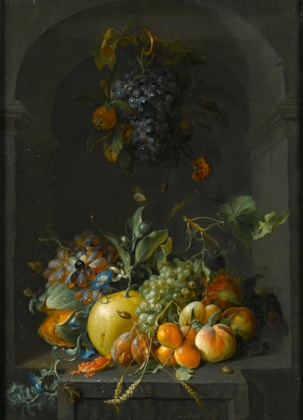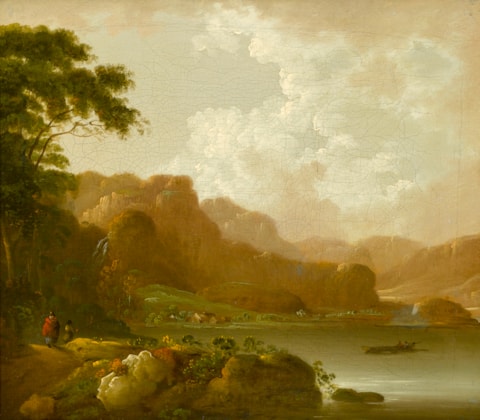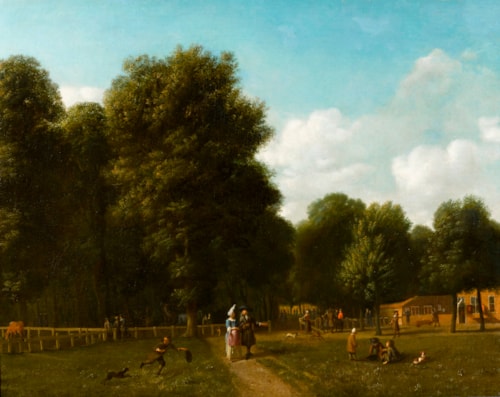rnest Karl Eugen Koerner
(Stibbe, Poland 1846 - Berlin 1927)
On the Golden Horn before the Sülemaniye Mosque, Constantinople
signed and dated 'Ernest Koerner 1922' (lower left)
oil on canvas
34.2 x 51.3 cm (13½ x 20¼ in)
‘White founts falling in the courts of the sun,
And the Soldan of Byzantium is smiling as they run;
…………….
The cold queen of England is looking in the glass;
The shadow of the Valois is yawning at the Mass;
From evening isles fantastical rings faint the Spanish gun,
And the Lord upon the Golden Horn is laughing in the sun’
- G.K. Chesterton, Lepanto, lines 1-2 and 11-14
In On the Golden Horn before the Sülemaniye Mosque, Constantinople, the radiant effects of the sun of Chesterton’s poem are illustrated by Ernest Karl Eugen Koerner. This extensive view across the Golden Horn looks towards the Bosphorus and takes in many of Istanbul's most famous monuments. From left to right we can see: The Haghia Sophia, converted into a mosque under Mehmed II, and which served as a model to many Ottoman mosques in Istanbul; the Blue Mosque, with its distinctive six minarets; the Süleymaniye Mosque (1550 - 1557), an Ottoman imperial mosque and the second largest mosque in the city; the Beyazit Tower, a marble fire-watching station built in 1828 on the site of Eski Saray, (the palace first inhabited by Mehmet the Conqueror after Byzantium fell to the Ottomans); and the Fatih Mosque.
The Golden Horn itself is the horn-shaped inlet of the Bosphorus which divides the city of Istanbul and forms a natural harbour in which the Byzantine and Ottoman fleet and commercial ships were once moored. According to Greek legend, the Golden Horn was named by Byzas the Megarian after his mother, Keroessa. The name may perhaps also be an expression of the golden colour that the water takes on at sunset, so beautifully represented in the present work.
There is a larger version of the present work which was also painted by Koerner in 1922, residing in a private collection. This larger version is paired with a view of the Bosphorus, and so it seems feasible that the present work was also once part of a pair. View of the Bosphorus (1922, Private Collection) has the same combination of stunning panorama and exquisite detailing, which makes On the Golden Horn before the Sülemaniye Mosque, Constantinople such an appealing work.
Koerner was a German colourist of the School of Berlin. He was born in 1846, lived in Berlin and earned the support of several monarchs, including Wilhelm I and Wilhelm II. He was the recipient of numerous awards from around the world: Vienna 1873, Philadelphia 1876, Melbourne 1889, and Berlin 1891.
His preferred subjects were the interiors of architecturally remarkable buildings such as the Alhambra, or the Alcazar in Sevilla, Spain. In these he showed a keen understanding of specific architectural features, while creating a poetic atmosphere through the application of colour and light. Other paintings of the Golden Horn by Koerner include The Golden Horn, from Tepebasi looking at the Beyazit Tower and View across the Golden Horn, Constantinople, 1913, both in private collections. He is also noted for his Orientalist works, predominantly views of Turkey and Egypt.
‘White founts falling in the courts of the sun,
And the Soldan of Byzantium is smiling as they run;
…………….
The cold queen of England is looking in the glass;
The shadow of the Valois is yawning at the Mass;
From evening isles fantastical rings faint the Spanish gun,
And the Lord upon the Golden Horn is laughing in the sun’
- G.K. Chesterton, Lepanto, lines 1-2 and 11-14
In On the Golden Horn before the Sülemaniye Mosque, Constantinople, the radiant effects of the sun of Chesterton’s poem are illustrated by Ernest Karl Eugen Koerner. This extensive view across the Golden Horn looks towards the Bosphorus and takes in many of Istanbul's most famous monuments. From left to right we can see: The Haghia Sophia, converted into a mosque under Mehmed II, and which served as a model to many Ottoman mosques in Istanbul; the Blue Mosque, with its distinctive six minarets; the Süleymaniye Mosque (1550 - 1557), an Ottoman imperial mosque and the second largest mosque in the city; the Beyazit Tower, a marble fire-watching station built in 1828 on the site of Eski Saray, (the palace first inhabited by Mehmet the Conqueror after Byzantium fell to the Ottomans); and the Fatih Mosque.
The Golden Horn itself is the horn-shaped inlet of the Bosphorus which divides the city of Istanbul and forms a natural harbour in which the Byzantine and Ottoman fleet and commercial ships were once moored. According to Greek legend, the Golden Horn was named by Byzas the Megarian after his mother, Keroessa. The name may perhaps also be an expression of the golden colour that the water takes on at sunset, so beautifully represented in the present work.
There is a larger version of the present work which was also painted by Koerner in 1922, residing in a private collection. This larger version is paired with a view of the Bosphorus, and so it seems feasible that the present work was also once part of a pair. View of the Bosphorus (1922, Private Collection) has the same combination of stunning panorama and exquisite detailing, which makes On the Golden Horn before the Sülemaniye Mosque, Constantinople such an appealing work.
Koerner was a German colourist of the School of Berlin. He was born in 1846, lived in Berlin and earned the support of several monarchs, including Wilhelm I and Wilhelm II. He was the recipient of numerous awards from around the world: Vienna 1873, Philadelphia 1876, Melbourne 1889, and Berlin 1891.
His preferred subjects were the interiors of architecturally remarkable buildings such as the Alhambra, or the Alcazar in Sevilla, Spain. In these he showed a keen understanding of specific architectural features, while creating a poetic atmosphere through the application of colour and light. Other paintings of the Golden Horn by Koerner include The Golden Horn, from Tepebasi looking at the Beyazit Tower and View across the Golden Horn, Constantinople, 1913, both in private collections. He is also noted for his Orientalist works, predominantly views of Turkey and Egypt.





 contact
contact contact
contact +44 20 7313 8040
+44 20 7313 8040









